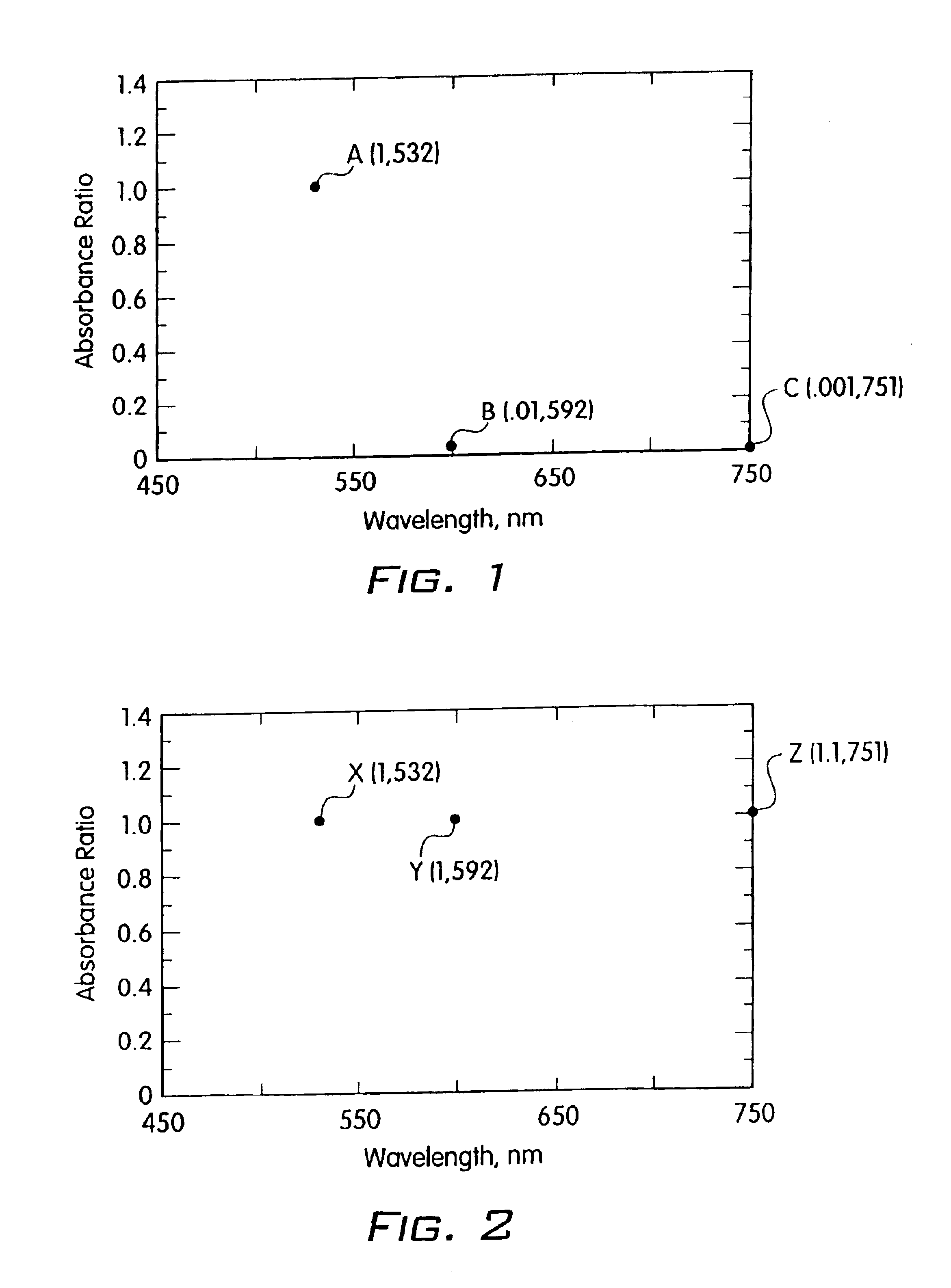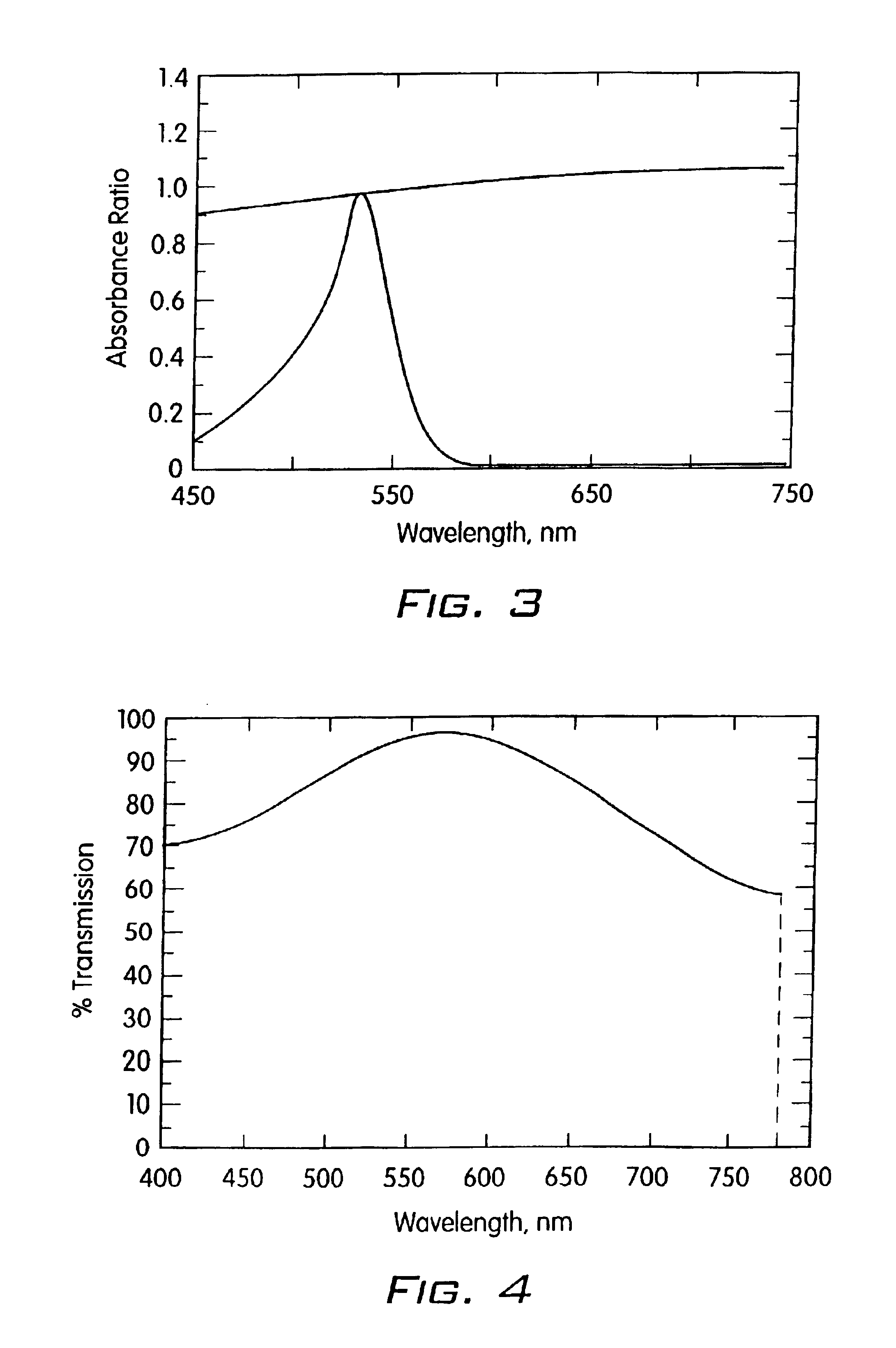Visibly transparent dyes for through-transmission laser welding
a laser welding and transparent technology, applied in the field of transparent dyes, can solve the problems of slow linear welding speed, poor appearance of final welds, uncontrolled radiation scattering, etc., and achieve the effect of reducing the cost of dye production
- Summary
- Abstract
- Description
- Claims
- Application Information
AI Technical Summary
Benefits of technology
Problems solved by technology
Method used
Image
Examples
example 1
Calculating the Absorbance Ratio for a Candidate Dye
[0042]The substrate was doped with a notch absorber at a concentration of between 0.05 and 0.10 grams per pound of substrate. In this example, the notch includes the 532 nm wavelength of the doubled Nd:YAG laser. Accordingly the laser welding wavelength equals 532 nm (lww=532 nm). This value used in the denominator of Equation 1 will be constant for all calculations with this absorber.
[0043]Next we calculate the reference point for our Absorbance Ratio. The reference point by definition has an optical density (OD) of unity. The reference point is where the wv equals lww (532 wl−532 lww) as is calculated in Equation 1-A as follows: Absorbance Ratio(OD)=OD (Substrate+Dye@532 nm)-OD (Substrate@532 nm)OD (Substrate+Dye@532 nm)-OD (Substrate@532 nm)=1Equation 1-A
Note that the Absorbance Ratio will remain at 1 independent of concentration, substrate type, substrate transmission characteristics or substrate thicknes...
example 2
Calculating the Absorbance Ratio for Carbon Black
[0046]Next we calculate the Absorbance Ratio for a prior art compound, for example carbon black. We use the same reference point of 532 nm for the lww and we use the same wavelengths as above, 532 nm, 592 nm and 751 nm, for the wv value in the numerator. These points as shown as X, Y and Z on FIG. 2. The Absorbance Ratio at the reference point (X) is 1.0. The Absorbance Ratios at point Y is 1.0 and at point Z is 1.1. The following table presents a side-by-side comparison:
[0047]
Absorbance Ratios (ref. graph point)Wavelength532 nm AbsorberCarbon Black532 nm 1.0 (A)1.0 (X)592 nm 0.01 (B)1.0 (Y)751 nm0.001 (C)1.1 (Z)
[0048]FIG. 3 shows the full Absorbance Ratio curves for the 532 absorber and carbon black together. This graph readily shows that the 532 absorber effectively absorbs at the desired laser welding wavelength and absorbs 100 times and 1000 times less strongly at other points within the visible spectrum. Carbon black abs...
PUM
| Property | Measurement | Unit |
|---|---|---|
| transparent | aaaaa | aaaaa |
| wavelength | aaaaa | aaaaa |
| wavelengths | aaaaa | aaaaa |
Abstract
Description
Claims
Application Information
 Login to View More
Login to View More - R&D
- Intellectual Property
- Life Sciences
- Materials
- Tech Scout
- Unparalleled Data Quality
- Higher Quality Content
- 60% Fewer Hallucinations
Browse by: Latest US Patents, China's latest patents, Technical Efficacy Thesaurus, Application Domain, Technology Topic, Popular Technical Reports.
© 2025 PatSnap. All rights reserved.Legal|Privacy policy|Modern Slavery Act Transparency Statement|Sitemap|About US| Contact US: help@patsnap.com



